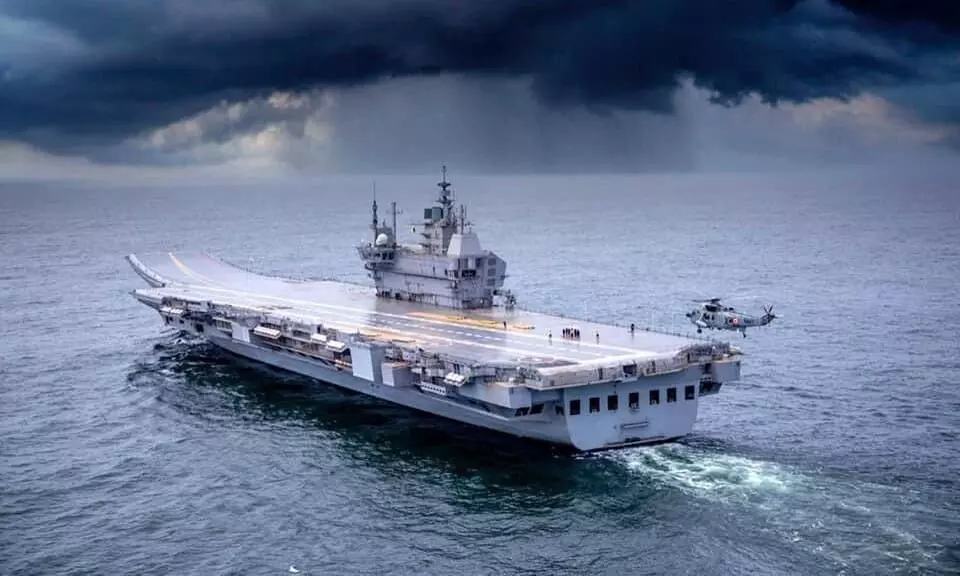The new INS Vikrant - and her debt to the old
Today the Indian Navy, and India, have a new INS Vikrant. For Indians of a certain age, such as this writer, there is an immense, goose-bump inducing resonance about that ship's name

Today the Indian Navy, and India, have a new INS Vikrant. For Indians of a certain age, such as this writer, there is an immense, goose-bump inducing resonance about that ship's name. It recalls a period when India, one of the first post-colonial independent countries, was one of the first to be defended, and represented in visits overseas, by this almost mystically powerful ship type, the aircraft carrier. And it recalls one of India's finest hours, when she pulled off a stunning, incontestable military victory.
And that victory was in pursuit of one of the most humanitarian and ethical objectives that any war has ever been fought for: stopping the (West) Pakistan Army's depredations in what was about to be transformed, from East Pakistan into Bangladesh. In India's long, rich and storied military history, there are few more stirring episodes than that, in which the original Vikrant played such a starring role.
The Indian Navy must be commended, on retaining the name (and, for ship enthusiasts, the pennant number R11), for this significant successor ship. The new Vikrant, India's fourth aircraft carrier, is the first one built in India. This is no mean achievement, and one that all Indians should be proud of.
She is also the largest warship constructed in India. At 45,000 tonnes, she has over twice the displacement of her earlier namesake. Other statistics, which the government's publicity releases abound in – over 2,000 compartments, over 2,000 km of cabling, stem-to-stern length of over 260 metres – are equally mind-boggling. Indeed they should be, for a modern ship of her size and sophistication. India is entirely within her rights to be proud of the new Vikrant and her vital statistics, and to celebrate her entry into the Indian Navy.
But amid the celebrations and publicity, it is actually healthy for India's defence, as well as her industrial capability and her project management skills, to take a long, hard look at a few "areas for improvement". That phrase will be familiar to anyone who has undergone a serious annual appraisal. And even in a year in which there has been much accomplishment, if we are genuinely concerned for India's security and development, it is good to quietly temper the celebrations with some long, hard looks at areas for improvement.
The first of these is simply the time taken to deliver. The new Vikrant's keel was laid in 2009, to bring her to commissioning today, a matter of thirteen years. To be sure, China spent twelve years tinkering with their first aircraft carrier, an ex-Soviet hulk which was sold to them stripped, refurbished with Russian machinery, and operationalised at least briefly. But they clearly learned their lessons. They took their second carrier, the first they built from the ground up, from start of construction to launch in just four years. Their third carrier (which is about twice the size of the new Vikrant), went from start of construction in 2017 to launch in June this year. While there is plenty of room to dispute comparisons, India's programme has definitely moved at a pace politely describable in comparison as elephantine.
A second area is the atma nirbharta of the project. A high indigenous content (76%) has been reported for the new Vikrant, but the reality is that her engines are American, her gearbox (a critical component in high-performance ships) German, much of her electronics are Israeli or French, her self-defence missiles Israeli, and her self-defence guns Italian or Russian. Her air group, which is what really defines her power, is likely to consist of Russian combat aircraft, Russian AEW helicopters, and American multi-role helicopters, leavened perhaps with a few Indian ALH Dhruv general purpose helicopters. Again, it is possible to justify and explain. It is not unpatriotic to question.
There remains a definite question over the vulnerability of aircraft carriers in a full-scale war against any but our weakest adversaries. The United States Navy, the world's largest and most experienced operator of aircraft carriers, invests huge material, financial and human resources in Carrier Strike Groups, formations of several other major surface warships whose sole purpose is to accompany and protect the aircraft carrier whose strike group they are assigned to. India's defence budget, which in percentage terms remains at its lowest share of national GDP since the debacle of 1962, does not yet run to providing our aircraft carriers with that kind of protection.
Even with that level of protection, the US Navy is known to be reluctant to risk their carriers within range of the coasts of countries which field "carrier-killer" class anti-ship missiles. Ukranian missiles of this type almost certainly account for Russia's loss of her 10,000 tonne cruiser Moskva (Russian denials notwithstanding) in April this year.
Returning to the initial point, the new INS Vikrant's entry into the Indian Navy, and the resurrection of that proud warship name, are events to be immensely proud of. It remains appropriate for informed Indians to be aware of the areas that require some improvement.



